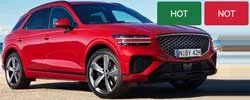You have to look at all that and much more, and it is not always straight forward in calculating appropriate offset, especially if you are trying to achieve a set up as flush with the fender as possible, and without having any poke (ie...when the wheel or tire sticks out slightly from the body). By the sounds of it, you need to do a bit more research and and gain more knowledge if you plan to figure this out yourself. There are a few threads where some have gone into detail, including me, on fitment considerations. Just a few quick notes:
- Centre rings have zero to do with offset. Hub centric wheels means the hole in the middle is the exact size of the hub flange on your vehicle, so it fits snug and is perfectly centered to eliminate vibration. Hyundai, Kia, Genesis centre bore is 67.1 (same as Mazda actually). Unless you go higher end wheel where the wheel hub is machined custom to your vehicle, then aftermarket wheels are likely to have a larger bore in the 73.something range to make the fitment more flexible with various vehicles. There are some cheaper brands that do make hub centric wheels, but I would be inclined to stay away from those. A set of hubcentric rings is $20 at most, and strongly advisable. These centre bore sizes are pretty standard and you can easily find them with inside and outside diameter to fill the gap of any wheel. Their main purpose is to keep the wheel absolutely centered on the hub when the lug nuts/bolts are tightened so there is no vibration. After the bolts are tightened, they play no role.
- OEM offset is ET 43 for 21 x 9 wheel with a 255/40/21 tire, ET 39 for the 19 x 8 wheel with a 235/55/19 tire.
- When considering offset, you need to take the wheel offset into account, wheel width, and tire section width (eg, if you are going with a wider tire that has a section width wider than the overall wheel, then it is the tire that is used to determine "how close to flush with fender" you will be). Also note that wheel width is the inside of the lip to inside of the lip...ie. where the tire beads sit. Some go with a wider wheel and the tire is narrower so it has a stretch.
- To calc offset, start with stock positioning and change parameters of tire width, wheel width, and offset. Some or all of these may come into play depending on widths, as per my comment above re: tire vs wheel width.
- Most go fairly safe if going with a 9" wide wheel @ ET+35 (in fact, most aftermarket wheels will offer this offset). That pushes the wheel out for a more aggressive stance, but not necessarily flush.
- Higher end wheels will custom machine the hub to desired offset. Others offer one or two offset choices in the wheel configuration that fits your vehicle. If you can settle for whatever is offered and not stuck on achieving flush, then your options for aftermarket wheels will be greater.
I just purchased 21" aftermarket wheels for summer that were custom fitted for my GV (ie. their hub machined to my desired and their recommended offset for flush (ie ET 32 as well as the centre bore drilled to 67.1 so no hub centric rings are required). I'll be going with a slightly wider tire (265/40/21 rather than stock 255/40/21), so my tire's section width is actually a bit wider than my wheel, so that is what factored into my calcs for offset.





























